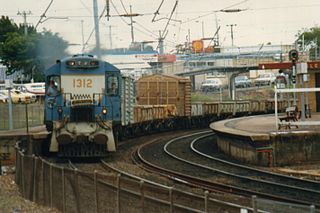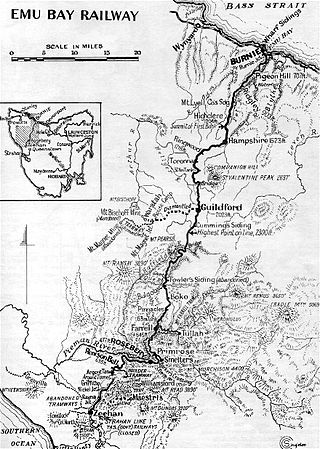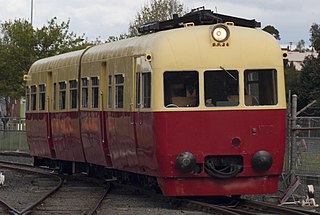
HobartHOH-bart; is the capital and most populous city of the island state of Tasmania, Australia. Located in Tasmania's south-east on the estuary of the River Derwent, it is the southernmost capital city in Australia. Despite containing nearly half of Tasmania's population, Hobart is the least-populated Australian state capital city, and second-smallest by population and area after Darwin if territories are taken into account. Its skyline is dominated by the 1,271-metre (4,170 ft) kunanyi / Mount Wellington, and its harbour forms the second-deepest natural port in the world, with much of the city's waterfront consisting of reclaimed land. The metropolitan area is often referred to as Greater Hobart, to differentiate it from the City of Hobart, one of the seven local government areas that cover the city. It has a mild maritime climate.

The River Derwent, also known as timtumili minanya in palawa kani, is a significant river and tidal estuary in Tasmania, Australia. It begins its journey as a freshwater river in the Central Highlands at Lake St Clair, descending over 700 metres (2,300 ft) across a distance of more than 200 kilometres (120 mi). At the settlement of New Norfolk in the Derwent Valley its waters become brackish, flowing through Hobart, the capital city of Tasmania, its seawater estuary eventually empties into Storm Bay and the Tasman Sea.

Derwent Valley Council is a local government body situated in southern-central Tasmania, west of Hobart. Derwent Valley is classified as a rural local government area and has a population of 10,290, it includes the localities of Bushy Park, Maydena and Strathgordon, with New Norfolk the major, principal town.

New Norfolk is a riverside town located on the River Derwent in southeastern Tasmania, Australia. Established in 1807, it is Tasmania’s fourth-oldest European settlement and ranks as the twelfth oldest in Australia. Initially founded by evacuees from Norfolk Island, New Norfolk has a population of 6,153 as of 2021 and serves as the main township of the Derwent Valley region. It lies 32 kilometres (20 mi) northwest of Hobart, along the Lyell Highway, and is encompassed within the Greater Hobart statistical area.

The Bridgewater Bridge is a combined road and rail bridge that carries the Midland Highway and South Railway Line across the Derwent River in Hobart, Tasmania, Australia. This steel truss vertical lift bridge and specially-built causeway connect the Hobart suburbs of Bridgewater and Granton. The bridge was completed in 1946 and accommodates a two-lane highway, a single track railway and a grade-separated footpath.

The Melba Line is a 1,067 mm narrow-gauge railway on the West Coast of Tasmania. The line was originally constructed as a private railway line named the Emu Bay Railway and was one of the longest-lasting and most successful private railway companies in Australia. While at present the line travels from Burnie to Melba Flats, it previously ran through to Zeehan carrying minerals and passengers as an essential service for the West Coast community.

The electoral division of Derwent is one of the 15 electoral divisions in the Tasmanian Legislative Council. It is situated in the central south of the state.

The Tasmanian Government Railways (TGR) was the former operator of the mainline railways in Tasmania, Australia. Formed in 1872, the railway company was managed by the Government of Tasmania, and existed until absorption into the Australian National Railways Commission in 1978.

Rail transport in Tasmania consists of a network of narrow gauge track of 1,067 mm reaching virtually all cities and major towns in the island state of Tasmania, Australia. Today, rail services are focused primarily on bulk freight, with no commercial passenger services being operated. The mainline railways of Tasmania are currently operated by TasRail, a Government of Tasmania-owned Corporation, who owns and maintains both rolling stock, locomotives, and track infrastructure.

The Y class is a class of diesel locomotives built by the Tasmanian Government Railways between 1961 and 1971.
Westerway is a rural locality in the local government areas (LGA) of Central Highlands and Derwent Valley in the Central and South-east LGA regions of Tasmania. The locality is about 29 kilometres (18 mi) north-west of the town of New Norfolk. The 2016 census has a population of 225 for the state suburb of Westerway.

The 1300 class were a class of diesel locomotive built by English Electric, Rocklea for Queensland Rail between 1967 and 1972. They were later sold to AN Tasrail.

The Brighton Transport Hub is an intermodal transport hub in the northern Hobart suburb of Brighton operated by TasRail.

The South Line, also known as the Main Line and sometimes the North/South Line or the North–South Line, is a rail corridor connecting Hobart to the northern ports of Tasmania. The Railway Line was built by the Tasmanian Main Line Company.

The Emu Bay Railway was a Tasmania, Australian railway company. The railway was significant during full operation, in that it linked the Tasmanian Government Railways system at Burnie with that at Zeehan that further linked to the Mount Lyell railway allowing connection through to Queenstown.

TasRail is a Tasmanian Government state-owned enterprise that has operated the mainline railways in Tasmania since September 2009. It operates only freight services.

AN Tasrail was an Australian railway operator that operated the Tasmanian rail network from March 1978 until November 2004. Originally a subsidiary of the Federal Government's Australian National, it was sold to Australian Transport Network (ATN) in November 1997. ATN was acquired by Pacific National in 2004 and the AN Tasrail subsidiary was later acquired by the Tasmanian Government in 2009 to become TasRail.

The Tasman Limited was a passenger train operated by Tasmanian Government Railways (TGR) on the Main and Western lines between Hobart, Launceston and Wynyard from April 1954 to July 1978.
Florentine Junction, also known as Pillinger’s Creek, Risby’s Junction, Florentine Rail Yard and Florentine Depot, is the terminus of the Derwent Valley Railway, a 3’ 6” narrow gauge railway that operates from New Norfolk in Tasmania, Australia. The station opened in 1936 but closed in the mid twentieth century when the railway beyond Kallista was closed.

The DQ class were a class of diesel locomotives in New Zealand and Tasmania. Originally built by Clyde Engineering in the 1960s as Queensland Rails 1460 and 1502 class locomotives. They were purchased by Tranz Rail in 1995 to be rebuilt, as a cheaper alternative to buying new locomotives. Tranz Rail rebuilt 16 locos into the DQ class. Tranz Rail then sold the 12 DQs to AN Tasrail. Only eight out of the twelve DQs are still in service today.

















